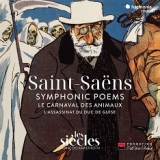Es fehlt nicht an guten Aufnahmen von Tondichtungen des französischen Komponisten Camille Saint-Saëns (1835-1921), aber diese hier schafft es ins Spitzenpeloton.
François-Xavier Roth dirigiert sein Orchester Les Siècles, das wiederum auf zeitgenössischen Instrumenten spielt, aber das ist nicht das wichtigste Argument für dieses Doppelalbum. Mich überzeugt vor allem der schlanke und wendige Orchesterklang. Roth lässt ohne jede Schwere, ohne ein Gramm Pathos musizieren.
Der federnde Orchesterklang sowie die vielen Farben und dynamischen Nuancen wie auch das rhythmische Raffinement wirken Wunder in Phaéton. Den Beginn von La Jeunesse d’Hercule habe ich noch nicht so spannungsvoll-mysteriös gehört wie bei Roth, und Le rouet d’Omphale gelingt ihm mit einem ebenfalls großartigen Raffinement.
Seine Danse macabre ist speziell. Er legt das Gewicht eher auf das Tänzerische denn auch das Makabre. Es ist ein leichter, luftiger und beschwingter Tanz, den wir hören. Es folgt ein opulentes und spannungsvolles Bacchanal, ehe uns Roth mit einer wiederum sehr speziellen Interpretation des Carnaval des Animaux überrascht. Er führt es natürlich mit einem kleinen Ensemble auf und benutzt einen sogenannten Doppelflügel von Pleyel (ein einiges Instrument mit nur einem ‘Körper“, aber zwei Tastaturen, zwei Saitensystemen mit dazu gehöriger Mechanik. Der Carnaval wird sehr gestisch und humorvoll gespielt, mit einer guten Klangvisualisierung der Handlung dieser zoologischen Fantasie.
Mit ‘L’Assassinat du duc de Guise’ für den Film von André Calmettes und Charles Le Bargy komponierte der 73-jährige Saint-Saëns die erste originale Filmmusik überhaupt. Die Musik für 12 Instrumentalisten (Flöte, Oboe, Klarinette, Fagott, Horn, 5 Streicher, Klavier und Harmonium) erklingt hier in einer luxuriösen und stimmungsvoll-dramatischen Interpretation.
There is no shortage of good recordings of tone poems by the French composer Camille Saint-Saëns (1835-1921), but this one makes it into the top peloton.
François-Xavier Roth conducts his orchestra Les Siècles, which in turn plays on contemporary instruments, but that is not the most important argument in favor of this double album. I am particularly impressed by the slender and agile orchestral sound. Roth makes music without any heaviness, without an ounce of pathos.
The supple orchestral sound, the many colors and dynamic nuances as well as the rhythmic refinement work wonders in Phaéton. I have never heard the beginning of La Jeunesse d’Hercule as thrillingly mysterious as in Roth’s music, and he succeeds in Le rouet d’Omphale with equally magnificent refinement.
His Danse macabre is special. He emphasizes the dance rather than the macabre. It is a light, airy and lively dance that we hear. This is followed by an opulent and exciting bacchanal before Roth surprises us with another very special interpretation of Carnaval des Animaux. He performs it with a small ensemble, of course, and uses a so-called double grand piano by Pleyel (an instrument with only one ‘body’, but two keyboards and two string systems with associated mechanics. The Carnaval is played very gesturally and humorously, with a good sound visualization of the plot of this zoological fantasy.
With ‘L’Assassinat du duc de Guise’ for the film by André Calmettes and Charles Le Bargy, the 73-year-old Saint-Saëns composed the first original film music ever. The music for 12 instrumentalists (flute, oboe, clarinet, bassoon, horn, 5 strings, piano and harmonium) is performed here in a luxurious and atmospherically dramatic interpretation.
























